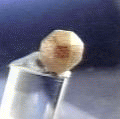CRYSTAL SYSTEMS,
| ||||||||||||||||||||
Minerals usually form distinct crystals. The shape of the crystals has been found to play an important role in the identification of minerals. The study of crystals is called crystallography and is an important field of study. Not only do scientists in this field study natural crystals but also the crystals formed by metal alloys, chemicals, and other synthetic materials. Often it is the use of crystallographic tools, such as an x-ray spectrometer, that find and distinguish new minerals as well as verify or correct the identification of specimens. It is through the use of these tools that the structure of a crystal can be gleaned.
How can crystallography help an ordinary rockhound to identify minerals? A mineral's crystalline structure, the arrangement of its component atoms and/or ions, is responsible for the outward shape of the crystal (see crystal habits and crystal forms). Rarely does one mineral form crystals that are completely unique to itself. Rather, a mineral will form crystals that are consistent with the symmetry class that the mineral falls into, based on its own structure. Also, symmetry affects a number of other properties such as cleavage, luster, hardness and at times color. Understanding what symmetry class a mineral belongs to is very helpful in identifying its crystals.
There are several symmetry operations that help define the crystal's outward symmetry. These operations represent the way a crystal can repeat the facets or faces on their crystal's surface.
One way to repeat a face is with a mirror plane that can reflect a face from one side of the crystal to the other. Consequent to being reflected by a mirror plane, the reflected face must be identical but reversed in orientation. In other words, if the original face has any right handed characteristics, then the reflected face must have the same characteristics but with a left handed slant to them.
A rotational axis is a line imaginarily drawn through the crystal that acts as an axis just like the axis for a tire. A face can be repeated on a crystal when the crystal is rotated around this axis and a new face is left at various intervals during the rotation. Consequent to being rotated is that the face must be identical to the original face when the face is viewed head on. In other words, if the face has a right handed slant and is rotated, the rotated faces must keep the right handed slant.
The interval for dropping a face is determined by a division of the full turn into equal segments. For example, to drop four faces on a crystal the rotation requires a stop at every 90 degrees and this type of rotation is called a four fold rotational axis. Rotational axes can have rotations of 1, 2, 3, 4 and 6 fold. Thus the 1 fold axis rotates the crystal in 360 degree intervals, the 2 fold interval is 180 degrees, the 3 fold interval is 120 degrees, the 4 fold interval is 90 degrees and the 6 fold interval is 60 degrees.
A rotoinversion axis goes one step further, by after rotating once and before dropping a face, it inverts the face through the crystal's center to the other side. The resulting face is completely flipped, i.e., up is down and right is left. The rotoinversion continues until it returns to the original starting face. Rotoinversion is constrained by the same rules for the simple rotational axes with the same folds or turns and degrees.
Finally a symmetry operation called a center is all that is left of symmetry operations to discuss. A center is simply, or perhaps not so simply, an operation that takes a face on one side of a crystal and inverts it through the center of the crystal. This has the same effect as the inversion in a rotoinversion operation in that the face is completely flipped up to down and right to left. Every point in a crystal is inverted to the other side of the crystal. Usually, a center is one operation that is all but ignored in most crystals because it is often caused by the juxtaposition of other symmetry operations. However in the triclinic system it is the only possible symmetry operation except for a one fold rotational axis, which is actually just returning a crystal face to its original position.
Other axes mentioned are crystallographic axes that are used by crystallographers like geometric axes to plot the faces and symmetry elements and their orientations within the crystal. These axes may or may not be part of the symmetry of the crystals. But they usually are since crystallographers will often orient the crystallographic axes along the planes and axes of symmetry.
Below is a list of links to the seven crystallographic systems and their member classes. Listed with the systems are the minimal requirements for a mineral to belong to that particular group. All crystalline solids can be classified as belonging to one of these systems based on its structure and inherent symmetry. Substances that are non-crystalline are called amorphous (without form) and are thus not classified.
THESE ARE THE SEVEN CRYSTALLOGRAPHIC SYSTEMS:
- ISOMETRIC, requires 4 three fold axis of rotation.
- TETRAGONAL, requires 1 four fold axis of rotation.
- HEXAGONAL, requires 1 six fold axis of rotation.
- TRIGONAL, requires 1 three fold axis of rotation.
- ORTHORHOMBIC, requires either 3 two fold axis of rotation or 1 two fold axis of rotation and two mirror planes.
- MONOCLINIC, requires either 1 two fold axis of rotation or 1 mirror plane.
- TRICLINIC, requires either a center or only translational symmetry.
-
AMORPHOUS ; no symmetry is present and it is therefore not a crystallographic system.

ISOMETRIC SPINEL |

TETRAGONAL AUTUNITE |
 HEXAGONAL HANKSITE |

TRIGONAL DIOPTASE
|

ORTHORHOMBIC CERUSSITE |

MONOCLINIC HEULANDITE |

TRICLINIC MICROCLINE |

AMORPHOUS PRECIOUS OPAL |
Much information for these pages was provided by The Minerology Database.








